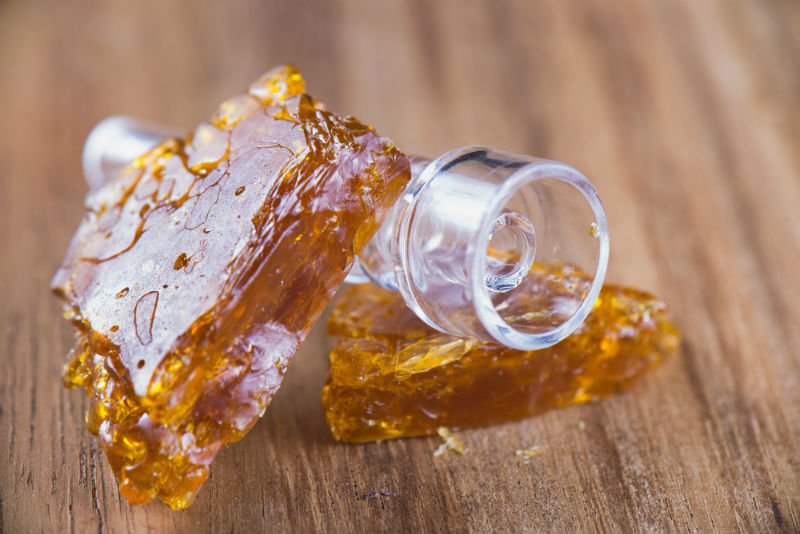Cannabis extracts (CEs) have surged in popularity as legalization has continued to sweep the nation. One of the most preferred methods of CE consumption is vaporization.
CEs are usually made using solvents such as butane/propane, ethanol, or supercritical carbon dioxide (CO2). Recently, it’s become popular to use heat and mechanical pressure to create solventless “rosin.” [1] Unfortunately, across the U.S. and illicit markets in other countries, pine rosin (from pine trees) has been found in a number of CE products (e.g., hashish and BHO). [2] It was also recently identified in cannabis vaporizer extract. [2]
According to the analysis by Portland State University, “[Pine rosin’s] inhalation toxicity poses a significant health concern to users… pine rosin fumes are released during soldering, and have been cited as a causative agent of occupational asthma. Symptoms also include desquamation of bronchial epithelium, which has been observed in EVALI [e-cigarette, or vaping, product use-associated lung injury] patients.” [2]
Contaminants may be found in cannabis vaporizer products since these products can contain a fluidizing agent for the sake of greater wicking efficiency. While some of the safer agents include terpenes and terpenenoids [3], a number of dangerous contaminating agents have also been used. [2]
Most recently, we suffered a vaporizer pandemic linked to vitamin E acetate (VEA), causing a number of lung problems and even fatalities in those who consumed these products. VEA’s primary role was to work as a diluent and thickening agent, making the CE appear as though it wasn’t adulterated. [4]
Pine rosin (sometimes referred to as rosin colophony or pine resin) was recently found to have been used for a similar purpose in cannabis vaporizers. [2] Prior to this year, this adulterant had not been reported in cannabis vaporizer extract. Pine rosin remains available through several legal online vendors and, potentially, illegal vendors. In this case, the adulterant came from a cannabis vaporizer manufacturer. Though solid at room temperature, mixing with medium-chain triglyceride (MCT) oil provided a “final appearance very similar to pure THC or clarified cannabis extract.” [2]
“Occupational exposure to pine rosin vapor from solder flux at levels of 50 μg/m, the 8-h Time Weighted Average (TWA) exposure limit, has not been known to produce sever acute lung injuries,” the Portland University analysis continues. “However, [adulterant] added to CE at a level of just 1% will produce nearly 0.6 g/m³ of pine rosin in the aerosol from a cannabis vaporizer pen with each puff, or ~3,500 times the 15-min TWA exposure limit.” [2]
It’s important to remember that cannabis vaporization products are still relatively new technology. We don’t have a complete understanding of the effects these products have — particularly, in the long-term. What’s certain is that adulterants are sometimes added to these products, usually through illicit operations.
References
- Lamy FR, et al. “You Got to Love Rosin: Solventless Dabs, Pure, Clean, Natural Medicine: Exploring Twitter Data on Emerging Trends in Rosin Tech Marijuana Concentrates.” Drug Alcohol Depend, vol.183, 2018, pp.248-252, doi:10.1016/j.drugalcdep.2017.10.039. Impact Factor: 3.590 Times Cited: 4 (ResearchGate)
- Meehan-Attrash J, Strongin R. “Pine Rosin as a Toxic Cannabis Extract Adulterant.” Portland State University, preprint, 2020, https://pdxscholar.library.pdx.edu/chem_fac/296/. Impact Factor: N/A Times Cited: N/A
- Coffin, M. “Viscosity reduction of High Potency Cannabis Oils: The Case for 100% Cannabis-Derived Formulations,” Extraction Magazine, Nov-Dec 2019.
- Boudi FB, et al. “Vitamin E Acetate as a Plausible Cause of Acute Vaping-related Illness.” Cureus, vol.11, no.12, 2019, p.e6350, doi:10.7759/cureus.6350. Impact Factor: N/A Times Cited: 3 (ResearchGate)
Image by Trần Tiến Lộc Đỗ from Pixabay








